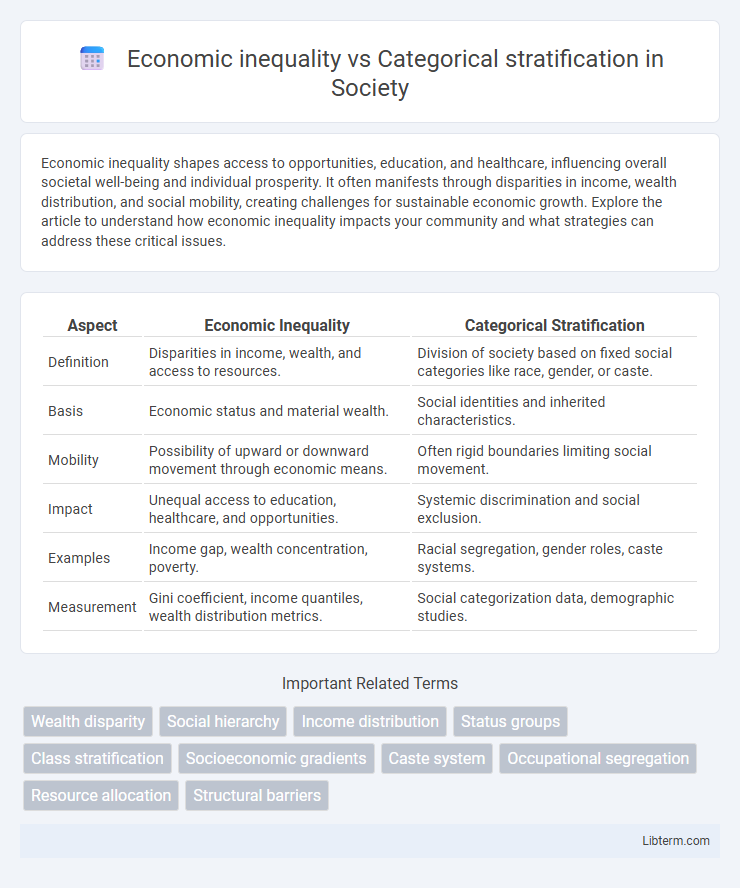Economic inequality shapes access to opportunities, education, and healthcare, influencing overall societal well-being and individual prosperity. It often manifests through disparities in income, wealth distribution, and social mobility, creating challenges for sustainable economic growth. Explore the article to understand how economic inequality impacts your community and what strategies can address these critical issues.
Table of Comparison
| Aspect | Economic Inequality | Categorical Stratification |
|---|---|---|
| Definition | Disparities in income, wealth, and access to resources. | Division of society based on fixed social categories like race, gender, or caste. |
| Basis | Economic status and material wealth. | Social identities and inherited characteristics. |
| Mobility | Possibility of upward or downward movement through economic means. | Often rigid boundaries limiting social movement. |
| Impact | Unequal access to education, healthcare, and opportunities. | Systemic discrimination and social exclusion. |
| Examples | Income gap, wealth concentration, poverty. | Racial segregation, gender roles, caste systems. |
| Measurement | Gini coefficient, income quantiles, wealth distribution metrics. | Social categorization data, demographic studies. |
Defining Economic Inequality and Categorical Stratification
Economic inequality refers to the unequal distribution of wealth, income, and resources among individuals or groups within a society, often measured by metrics such as the Gini coefficient or income quintiles. Categorical stratification involves social hierarchies based on distinct categories like race, gender, or ethnicity, which systematically influence individuals' access to opportunities and resources. Understanding economic inequality requires analyzing disparities in financial capital, while categorical stratification emphasizes structural divisions rooted in social identities and institutional discrimination.
Historical Roots of Economic Disparities and Social Hierarchies
Economic inequality originates from historical systems such as feudalism and colonialism, which entrenched wealth and resource disparities along class and racial lines. Categorical stratification reinforces these economic gaps by embedding social hierarchies in institutions, law, and culture, often privileging dominant groups over marginalized communities. Understanding these historical roots reveals how persistent social structures perpetuate unequal access to education, employment, and political power.
Key Theories Explaining Economic Inequality
Key theories explaining economic inequality include Marx's conflict theory, which emphasizes class struggle between the bourgeoisie and proletariat, and Weber's multidimensional stratification model that incorporates class, status, and power. Human capital theory attributes disparities to differences in education, skills, and experience, while the structural functionalism perspective views inequality as necessary for motivating individuals to fill different societal roles. Recent theories highlight the role of social networks, discrimination, and policy frameworks in perpetuating economic inequality across categorical boundaries such as race, gender, and ethnicity.
Classification Systems in Categorical Stratification
Classification systems in categorical stratification organize social groups based on fixed attributes such as race, ethnicity, gender, or caste, creating rigid hierarchies that limit social mobility. Economic inequality, in contrast, is primarily measured through income, wealth, and access to resources, which can fluctuate over time. Categorical stratification embeds disparities in social institutions and cultural norms, making inequalities more persistent and deeply rooted compared to economic stratification's fluid metrics.
Indicators and Measures: Wealth, Income, and Social Categories
Economic inequality is primarily measured through indicators such as wealth distribution, income levels, and consumption patterns, reflecting disparities in monetary resources among individuals or groups. Categorical stratification involves social categories such as class, race, gender, and education, which structure access to resources and opportunities beyond pure economic factors. Measures of categorical stratification include occupational status, social prestige, and educational attainment, revealing how social categories intersect with economic inequalities to shape overall stratification in society.
The Interplay Between Class, Race, and Gender in Stratification
Economic inequality and categorical stratification interact through complex dynamics where class, race, and gender collectively shape social hierarchies. Class disparities often overlap with racial and gender biases, producing compounded disadvantages for marginalized groups in income, education, and employment opportunities. This intersectional framework reveals how systemic barriers maintain unequal resource distribution and limit social mobility across multiple identity axes.
Economic Inequality’s Impact on Social Mobility
Economic inequality significantly hampers social mobility by restricting access to quality education, healthcare, and employment opportunities for lower-income groups. This creates entrenched economic disparities that perpetuate cycles of poverty and limit upward movement across socioeconomic classes. Data shows that countries with higher economic inequality exhibit lower rates of intergenerational mobility, emphasizing the critical role of wealth distribution in shaping social outcomes.
Policy Approaches to Reducing Economic and Categorical Gaps
Targeted policy approaches to reducing economic inequality often include progressive taxation, minimum wage laws, and social welfare programs designed to redistribute income and improve access to education and healthcare. To address categorical stratification, policies emphasize anti-discrimination laws, affirmative action, and equal opportunity measures that dismantle barriers based on race, gender, or ethnicity. Combining economic redistribution with robust legal protections promotes inclusive growth and reduces structural disparities across social groups.
Global Perspectives: Comparing Stratification Across Societies
Economic inequality manifests variably across societies, influenced by categorical stratification such as class, ethnicity, and gender, which shape access to resources and opportunities globally. In developed nations, economic disparities often intersect with systemic racial and gender hierarchies, while in developing countries, stratification aligns closely with caste, tribal affiliation, and colonial legacies. Comparative studies reveal that societies with rigid categorical boundaries sustain higher levels of persistent inequality, underscoring the complex interplay between economic status and social categories worldwide.
Future Trends and Solutions for Addressing Inequality and Stratification
Future trends in addressing economic inequality and categorical stratification emphasize the integration of technology-driven education and universal basic income policies, aiming to reduce wealth gaps and social immobility. Data from organizations like the World Economic Forum highlight the growing impact of automation on job displacement, requiring adaptive strategies that promote reskilling and inclusive economic participation. Targeted social reforms, such as progressive taxation and anti-discrimination laws, combined with improved access to healthcare and housing, offer comprehensive solutions to mitigate entrenched economic and social divides.
Economic inequality Infographic

 libterm.com
libterm.com